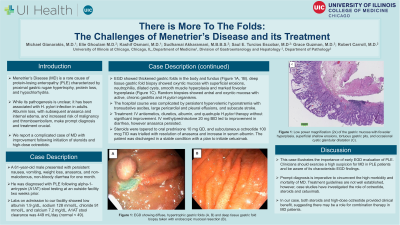Sunday Poster Session
Category: Stomach
P1419 - There Is More to the Folds: The Challenges of Menetrier’s Disease and Its Treatment
Sunday, October 22, 2023
3:30 PM - 7:00 PM PT
Location: Exhibit Hall

Has Audio

Michael Gianarakis, MD
University of Illinois at Chicago
Chicago, IL
Presenting Author(s)
Michael Gianarakis, MD1, Elie Ghoulam, MD1, Kashif Osmani, MD1, Sudhamai Akkaramani, MD1, Saul E. Turcios Escobar, MD1, Grace Guzman, MD2, Robert Carroll, MD1
1University of Illinois at Chicago, Chicago, IL; 2University of Illinois at Chicago, College of Medicine, Chicago, IL
Introduction: Menetrier’s Disease (MD) is a rare cause of protein-losing enteropathy (PLE) characterized by proximal gastric rugae hypertrophy, protein loss, and hypochlorhydria. While its pathogenesis is unclear, it has been associated with H. pylori infection in adults. Albumin loss, with subsequent anasarca and internal edema, and increased risk of malignancy and thromboembolism, make prompt diagnosis and treatment crucial. We report a complicated case of MD with improvement following initiation of steroids and high-dose octreotide.
Case Description/Methods: A 61-year-old male presented with persistent nausea, vomiting, weight loss, anasarca, and non-malodorous, non-bloody diarrhea for one month. He was diagnosed with PLE following alpha-1-antrypsin (A1AT) stool testing at an outside facility two weeks prior. Labs on admission to our facility showed low albumin 1.9 g/dL, sodium 128 mmol/L, chloride 91 mmol/L, and calcium 7.2 mg/dL. A1AT stool clearance was 449 mL/day (normal < 49).
EGD showed thickened gastric folds in the body and fundus (Figure 1A, 1B). Deep tissue gastric fold biopsy showed oxyntic mucosa with superficial erosions, neutrophilia, dilated cysts, smooth muscle hyperplasia and marked foveolar hyperplasia (Figure 1C). Random biopsies showed antral and oxyntic mucosa with active, chronic gastritis and H.pylori organisms.
The hospital course was complicated by persistent hypervolemic hyponatremia with transudative ascites, large pericardial and pleural effusions, and subacute stroke. Treatment included IV antiemetics, diuretics, albumin, and quadruple H.pylori therapy without significant improvement. IV methylprednisolone 20 mg BID led to improvement in diarrhea, however anasarca persisted. Steroids were tapered to oral prednisone 10 mg QD, and subcutaneous octreotide 100 mcg TID was trialed with resolution of anasarca and increase in serum albumin. The patient was discharged in a stable condition with a plan to initiate cetuximab.
Discussion: This case illustrates the importance of early EGD evaluation of PLE. Clinicians should exercise a high suspicion for MD in PLE patients and be aware of its characteristic EGD findings. Prompt diagnosis is imperative to circumvent the high morbidity and mortality of MD. Treatment guidelines are not well established, however, case studies have investigated the role of octreotide, steroids and cetuximab. In our case, both steroids and high-dose octreotide provided clinical benefit, suggesting there may be a role for combination therapy in MD patients.

Disclosures:
Michael Gianarakis, MD1, Elie Ghoulam, MD1, Kashif Osmani, MD1, Sudhamai Akkaramani, MD1, Saul E. Turcios Escobar, MD1, Grace Guzman, MD2, Robert Carroll, MD1. P1419 - There Is More to the Folds: The Challenges of Menetrier’s Disease and Its Treatment, ACG 2023 Annual Scientific Meeting Abstracts. Vancouver, BC, Canada: American College of Gastroenterology.
1University of Illinois at Chicago, Chicago, IL; 2University of Illinois at Chicago, College of Medicine, Chicago, IL
Introduction: Menetrier’s Disease (MD) is a rare cause of protein-losing enteropathy (PLE) characterized by proximal gastric rugae hypertrophy, protein loss, and hypochlorhydria. While its pathogenesis is unclear, it has been associated with H. pylori infection in adults. Albumin loss, with subsequent anasarca and internal edema, and increased risk of malignancy and thromboembolism, make prompt diagnosis and treatment crucial. We report a complicated case of MD with improvement following initiation of steroids and high-dose octreotide.
Case Description/Methods: A 61-year-old male presented with persistent nausea, vomiting, weight loss, anasarca, and non-malodorous, non-bloody diarrhea for one month. He was diagnosed with PLE following alpha-1-antrypsin (A1AT) stool testing at an outside facility two weeks prior. Labs on admission to our facility showed low albumin 1.9 g/dL, sodium 128 mmol/L, chloride 91 mmol/L, and calcium 7.2 mg/dL. A1AT stool clearance was 449 mL/day (normal < 49).
EGD showed thickened gastric folds in the body and fundus (Figure 1A, 1B). Deep tissue gastric fold biopsy showed oxyntic mucosa with superficial erosions, neutrophilia, dilated cysts, smooth muscle hyperplasia and marked foveolar hyperplasia (Figure 1C). Random biopsies showed antral and oxyntic mucosa with active, chronic gastritis and H.pylori organisms.
The hospital course was complicated by persistent hypervolemic hyponatremia with transudative ascites, large pericardial and pleural effusions, and subacute stroke. Treatment included IV antiemetics, diuretics, albumin, and quadruple H.pylori therapy without significant improvement. IV methylprednisolone 20 mg BID led to improvement in diarrhea, however anasarca persisted. Steroids were tapered to oral prednisone 10 mg QD, and subcutaneous octreotide 100 mcg TID was trialed with resolution of anasarca and increase in serum albumin. The patient was discharged in a stable condition with a plan to initiate cetuximab.
Discussion: This case illustrates the importance of early EGD evaluation of PLE. Clinicians should exercise a high suspicion for MD in PLE patients and be aware of its characteristic EGD findings. Prompt diagnosis is imperative to circumvent the high morbidity and mortality of MD. Treatment guidelines are not well established, however, case studies have investigated the role of octreotide, steroids and cetuximab. In our case, both steroids and high-dose octreotide provided clinical benefit, suggesting there may be a role for combination therapy in MD patients.

Figure: EGD showing diffuse, hypertrophic gastric folds (A, B) and deep tissue gastric fold biopsy taken with endoscopic mucosal resection (B). Low power magnification (2x) of the gastric mucosa with foveolar hyperplasia, superficial shallow erosions, tortuous gastric pits, and occasional cystic glandular dilatation (C).
Disclosures:
Michael Gianarakis indicated no relevant financial relationships.
Elie Ghoulam indicated no relevant financial relationships.
Kashif Osmani indicated no relevant financial relationships.
Sudhamai Akkaramani indicated no relevant financial relationships.
Saul Turcios Escobar indicated no relevant financial relationships.
Grace Guzman indicated no relevant financial relationships.
Robert Carroll: Takedz – Speakers Bureau.
Michael Gianarakis, MD1, Elie Ghoulam, MD1, Kashif Osmani, MD1, Sudhamai Akkaramani, MD1, Saul E. Turcios Escobar, MD1, Grace Guzman, MD2, Robert Carroll, MD1. P1419 - There Is More to the Folds: The Challenges of Menetrier’s Disease and Its Treatment, ACG 2023 Annual Scientific Meeting Abstracts. Vancouver, BC, Canada: American College of Gastroenterology.
